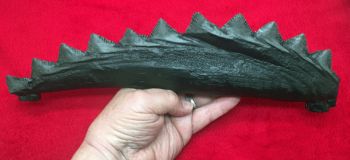
Edestus is an extinct genus of edestoid cartilaginous fish known from the Late Carboniferous (Pennsylvanian) of the United Kingdom, Russia, and the United States. Most remains consist of isolated curved blades or "whorls" that are studded with teeth, that in life were situated within the jaws. The largest species, E. heinrichi, has been conservatively estimated to reach greater than 6.7 m (22 ft) in length, around the size of the largest known great white shark.
Like its other relatives, such as Helicoprion, and unlike modern sharks, the species of Edestus grew teeth in curved blades or "whorls". In Edestus' case, only a single row of teeth occurred in the midline of each jaw, leading Edestus to sometimes be described as the "scissor tooth shark". The degree of curvature in the teeth brackets, along with size, are distinct in each species.
The whorls of Edestus are composed of numerous serrated teeth that have long v-shaped roots that are stacked on top of each other akin to roof tiling. Up to a dozen teeth are present in each whorl at any one time. Teeth grew in the back end (posterior) of the whorl, and gradually migrated forward through the whorl, before being ejected at the front end (anterior). Up to 40 teeth could have grown in each whorl during the lifetime of the animal. The upper and lower whorls are distinct in their morphology, with the lower whorl having a greater degree of curvature.
As with most cartilaginous fish, preserved skeletal material is rare, due to the cartilage of the skeleton having a poor potential for fossilization.
solid resin
13x3x1.5 inches
Item 3985
Category: Replicas
Type: Teeth
Phylum: Vertebrates
Class: Sharks
MORE PHOTOS:




Now Over 1,000 Items!
PrehistoricStore.com offers the largest selection of replica fossils and other fossil-related products anywhere in the world!
Download a Full Catalog (3MB PDF)
OVER 260 PAGES OF REPLICAS AND MORE!
